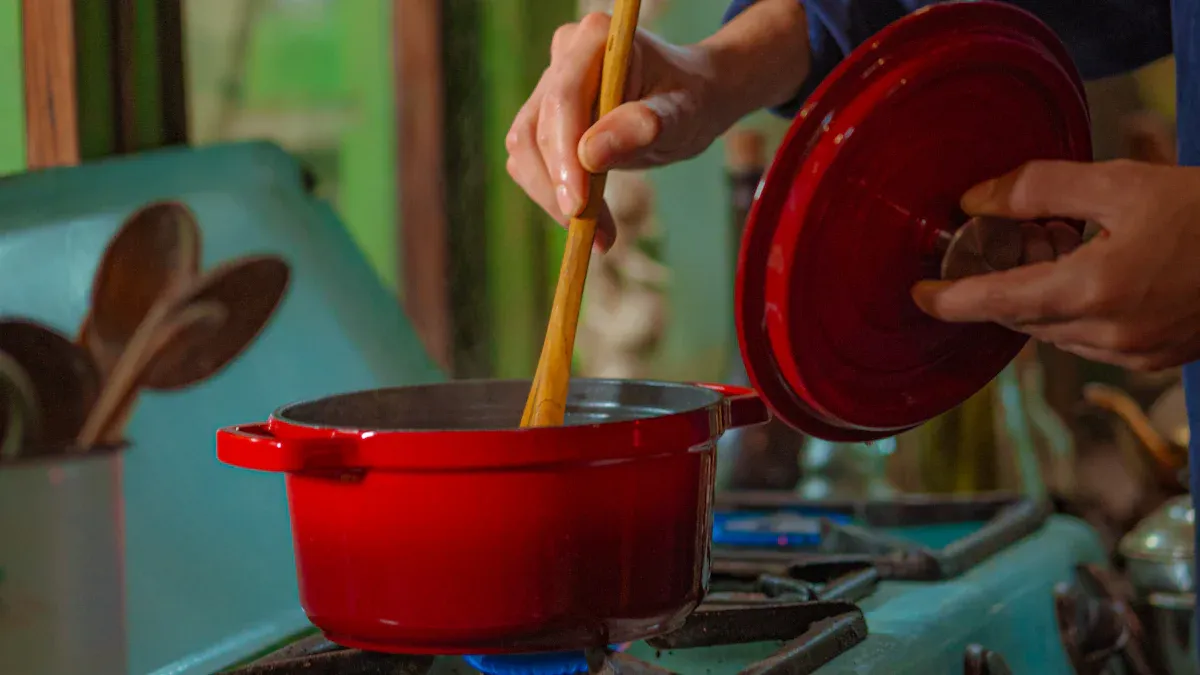
Lost your pot lid while cooking? Don’t panic! When your cookware pot lid is missing, you can still keep things under control. With a little creativity, you’ll find plenty of substitutes right in your kitchen. Let’s explore some quick fixes that’ll save your meal and your time.
Key Takeaways
- Use a strong plate or dish instead of a lid. Make sure it fully covers the pot to keep heat inside.
- Aluminum foil works well to cover pots tightly. It keeps steam and moisture in for better cooking.
- Think about buying a universal lid. It fits many pot sizes and makes cooking easier.
Best Substitutes When Your Cookware Pot Lid Is Missing
Use a Plate or Dish
When your cookware pot lid is missing, a sturdy plate or dish can come to the rescue. Look for one that’s slightly larger than the pot’s opening. This ensures it covers the pot completely and traps heat effectively. Ceramic or glass plates work best since they can handle higher temperatures.
Tip: Be cautious when removing the plate—it might get hot! Use silicone or cloth oven mitts or a thick towel to avoid burns.
If you’re simmering soup or boiling pasta, this quick fix works like a charm. Just make sure the plate isn’t too heavy, as it could tip the pot over.
Try a Baking Sheet or Baking Tray
A baking sheet or Baking tray is another excellent option. It’s flat, lightweight, and usually large enough to cover most pots. Plus, it’s heat-resistant, so you don’t have to worry about it warping or melting.
This substitute is especially handy when you’re cooking something that doesn’t require a tight seal, like sautéed vegetables or a quick stir-fry. Simply place the baking sheet on top of the pot, and you’re good to go.
Note: If your pot is steaming, leave a small gap for steam to escape. This prevents pressure from building up inside.
Cover with Aluminum Foil
Aluminum foil is a lifesaver when your cookware pot lid is missing. Tear off a sheet large enough to cover the pot, then press it tightly around the edges to create a seal. This method works well for steaming, braising, or slow cooking.
The foil traps heat and moisture, helping your food cook evenly. You can even poke a few small holes in the foil if you need to let steam escape.
Pro Tip: Double-layer the foil for extra durability, especially if you’re cooking for a long time.
Grab a Cutting Board
A wooden or plastic cutting board can double as a makeshift lid in a pinch. It’s a great option for covering pots when you’re frying or simmering at low heat. However, avoid using it for high-heat cooking, as the material could warp or get damaged.
Place the cutting board over the pot, ensuring it’s stable and doesn’t wobble. This method is perfect for keeping splatters contained while you cook.
Warning: Never use a cutting board over an open flame or in the oven—it’s not heatproof!
Repurpose a Frying Pan or Pizza Pan
Got a frying pan or pizza pan lying around? Use it as a lid! These items are usually wide enough to cover most pots and can handle high temperatures. A frying pan with a flat bottom works particularly well, as it creates a snug fit over the pot.
This substitute is ideal for tasks like boiling water, steaming vegetables, or cooking grains. Plus, it’s easy to grab and clean afterward.
Bonus: If your frying pan has a handle, it’s even easier to lift off when you need to check your food.
Use a Pyrex Lid or Crockpot Cover
If you have a Pyrex lid or a crockpot cover, you’re in luck. These are designed to withstand heat and often fit a variety of pot sizes. Check your kitchen cabinets—you might already have one that works perfectly.
Pyrex lids are especially useful for tasks like slow cooking or simmering, as they provide a clear view of your food while keeping the heat in. Crockpot covers, on the other hand, are great for larger pots and pans.
Quick Tip: If the lid doesn’t fit perfectly, it’s still better than nothing. Just center it as best as you can to trap the heat.
Solutions for Specific Cooking Needs
Sealing Tightly for Rice or Steaming
When you’re cooking rice or steaming vegetables, sealing the pot tightly is key. Without a proper lid, it might seem tricky, but you’ve got options! Aluminum foil is your best friend here. Tear off a large sheet, press it firmly around the edges of the pot, and voilà—you’ve created a snug seal. This traps steam and ensures your food cooks evenly.
If you’re out of foil, try using a heatproof plate. Place it over the pot and weigh it down with something heavy, like a small bowl or mug. This keeps the plate in place and prevents steam from escaping.
Pro Tip: Avoid using lightweight materials like plastic wrap. They can melt and ruin your dish (and your pot).
Covering Large Pots or Pans
Dealing with a big pot or pan? Finding a substitute for a missing lid can feel like a challenge, but don’t worry—you’ve got this. A baking sheet is a fantastic option for oversized cookware. It’s flat, sturdy, and usually large enough to cover most pots. Just place it on top, and you’re good to go.
If the baking sheet doesn’t fit, grab a clean kitchen towel and drape it over the pot. Then, place a large cutting board or tray on top to hold the towel in place. This combo works well for simmering soups or stews.
Note: Be careful with the towel—it can get damp from the steam. Make sure it doesn’t hang too close to the stove’s flame or heating element.
Preventing Splatter While Frying
Frying can get messy fast, especially when oil starts splattering everywhere. If your cookware pot lid is missing, you can still keep your kitchen clean. A splatter screen is the ideal tool for this, but if you don’t have one, a mesh strainer or sieve works just as well. Hold it over the pan while frying to catch the splatters.
Another option is to use a pizza pan or a lightweight frying pan as a cover. Just make sure to leave a small gap for steam to escape. This prevents condensation from dripping back into the oil, which could cause dangerous splashes.
Safety Tip: Never cover a frying pan completely. Trapping steam can create pressure and lead to accidents.
Safety Tips for Using Substitutes
Avoid Heat Damage to Non-Heatproof Items
When your cookware pot lid is missing, it’s tempting to grab whatever’s nearby. But not everything in your kitchen can handle heat. Avoid using plastic or thin glass items—they can melt or crack under high temperatures. Stick to materials like metal, ceramic, or tempered glass.
If you’re unsure whether an item is heatproof, play it safe. Test it by placing it near a warm surface for a few seconds. If it feels unstable or starts to warp, it’s not suitable for covering your pot.
Tip: Always double-check the heat resistance of your substitute before using it on the stove.
Ensure Proper Ventilation
Cooking often produces steam, and trapping it can lead to pressure buildup. This is especially true when using substitutes like plates or baking sheets. Always leave a small gap for steam to escape. You can tilt the cover slightly or poke a few holes in aluminum foil to allow airflow.
Proper ventilation not only prevents accidents but also helps your food cook evenly. For frying, avoid sealing the pan completely. Letting steam escape reduces the risk of splattering and keeps your dish crisp.
Safety Note: Never cover a pot so tightly that steam has no way out. It’s better to lose a little heat than to risk a dangerous situation.
Maintain Cleaning and Hygiene
Using substitutes means you’re repurposing items that might not usually cover pots. Before placing anything over your food, make sure it’s clean. Wash plates, trays, or cutting boards thoroughly to avoid contamination.
If you’re using a towel or foil, check for any dirt or residue. A clean substitute ensures your meal stays safe and delicious. After cooking, clean the substitute immediately to prevent grease or food particles from sticking.
Pro Tip: Keep a few clean kitchen towels or extra foil sheets handy for emergencies. They’re lifesavers when you’re in a pinch.
Why You Should Consider a Universal Lid

Advantages of a Universal Lid
Ever feel like you’re playing a game of “find the lid” every time you cook? A universal lid solves that problem instantly. It’s designed to fit multiple pot and pan sizes, so you don’t have to dig through your cabinets anymore.
Here’s why you’ll love it:
- Convenience: One lid for all your cookware means less clutter and more time for cooking.
- Versatility: Whether you’re simmering soup or frying veggies, it works for almost any dish.
- Durability: Most universal lids are made from sturdy materials like tempered glass or stainless steel, so they last for years.
Bonus: Some universal lids even have steam vents, making them perfect for steaming or preventing splatter.
Key Features to Look For
Not all universal lids are created equal. When shopping for one, keep an eye out for these must-have features:
- Adjustable Fit: Look for a lid that covers a range of sizes, like 8 to 12 inches.
- Heat Resistance: Choose materials that can handle high temperatures without warping.
- Easy Grip Handle: A cool-touch, ergonomic handle makes lifting the lid safe and comfortable.
- Transparent Design: A glass lid lets you monitor your food without lifting it.
Tip: If you cook often, consider a lid with a silicone rim. It creates a snug seal and prevents scratches on your pots.
Affordable Options for Every Budget
Think a universal lid will break the bank? Think again! You can find great options at every price point:
- Budget-Friendly: Basic models start as low as $10. They’re simple but get the job done.
- Mid-Range: For $20–$30, you’ll find lids with extra features like steam vents and silicone edges.
- Premium: High-end lids, priced around $40, often include advanced materials and sleek designs.
Pro Tip: Check online reviews before buying. They’ll help you find the best value for your money.
With a universal lid, you’ll never have to worry about missing lids again. It’s a small investment that makes a big difference in your kitchen!
Losing a pot lid doesn’t have to ruin your cooking plans. With these creative substitutes, you can keep your meal on track without missing a beat.
- Plates, baking sheets, and even aluminum foil can save the day.
- A universal lid? That’s a game-changer for long-term convenience.
What’s your go-to lid substitute? Share your clever ideas in the comments below!
Post time: Jun-03-2025

